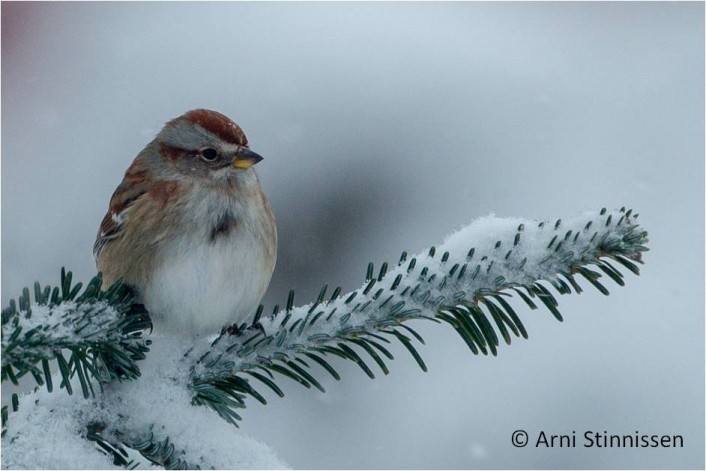Although it may not be as colourful and dazzling as other birds of winter such as chickadees, nuthatches, blue jays, juncos and northern shrikes, The American Tree sparrow is a welcomed visitor. One cannot deny its beauty either, for with its rufous- coloured crown and stripe behind its eye, the streaking on its back and the dark spot on its predominantly gray breast, it is a lovely looking bird.
“Tree sparrow” is a bit of a misnomer, for these birds spend little time in trees. They spend the summer near the northern tree line on the tundra, right across Canada, in scrubby open areas. In Ontario they are found hugging the coastline of Hudson’s Bay, where they build their, hard to find, nests in dense shrubs, thickets, grasses and muskeg.
Males arrive on the breeding grounds first, followed by females a week or so later. Males will carve out a territory and defends it vigorously while the female builds the nest of twigs, grasses and moss as well as feathers, mostly from ptarmigans. 4-6 pale bluish-green eggs with brown spots are laid and incubated for about 12 days by the female. Both male and female will feed chicks for two or three weeks after they have left the nest. Food consists of insects, caterpillars and seeds. With such short northern summers, American Tree Sparrows only have one brood per season.
Migration which takes place at night is a slow process. In small flocks of 20-30 individuals, they only travel as far south on any given day as they have to, feeding on seed heads rising above the snow. If snow has not accumulated to any great extent, and food is plentiful, we may not see them until late December or even January. When they do arrive, they are not bothered much by humans. While filling feeders in winter, I have had them perch on a branch only a couple of feet from where I was working. They can often be found foraging with Juncos at the base of feeders. Preferring millet over most other seeds, they will also eat nyger and other small seeds.
Most years, a few hundred individual birds are counted during the Orillia and Carden Annual Christmas Bird counts.
They are some of the first birds to leave our area in late winter and early spring, but before then search them out. Check under your feeders or in open fields with exposed plant stems carrying seeds. The major identifying mark is the dark dot on its breast.
David A. Homer is the President of the Board of Directors at The Couchiching Conservancy.

